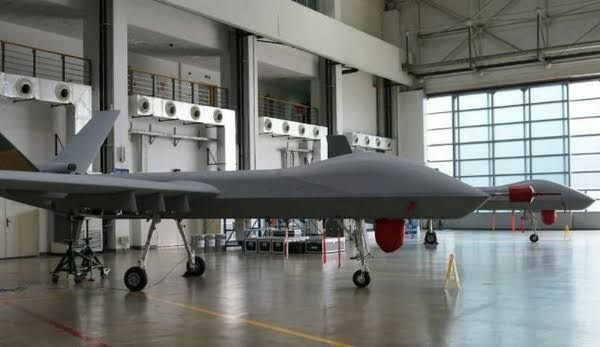The Nigerian Air Force has taken delivery of at least five Wing Loong II combat drones from China albeit discreetly. This acquisition marks a significant step forward for Nigeria’s military capabilities and further strengthens the country’s ability to combat insurgency and terrorism in the region.
In April, a Wing Loong-II with registration Number NAF 145 was seen in the hangar of 553 Base Service Group (BSG), ( formerly belonging to the 405 Helicopter Training Group (HCTG) NAF Base, Enugu.
The Wing Loong-IIs are NAF 141, 142, 143, 144 and 145.
This is not the first time that the Nigerian Air Force will quietly put into service a drone type. Two years ago, the Nigerian Air Force began operating the ADCOM Yabhon Flash-20 unmanned aerial vehicle (UAV) made in the United Arab Emirates.
At the same period, the Nigerian Air Force revealed its new combat UAV haul procured from China to take its drone warfare capacity to the next level.
This was first revealed in October 2020 by Nigeria’s Chief of Air Staff Air Marshal Sadique Abubakar during an operational visit to the Headquarters of the Air component of Operation Hadarin Daji in Kastina state.
The procured UCAVs includes at least two Wing Loong II, four CH-4Bs, and two CH-3Bs.
The UCAVs will cover several states including Zamfara, Sokoto, Kebbi, Kastina, and some part of Kaduna state.
The Wing Loong II is a medium-altitude, long-endurance unmanned aerial vehicle (UAV) designed and manufactured by the Chengdu Aircraft Industry Group (CAIG) of China. It is capable of flying at an altitude of up to 9,000 meters and has an endurance of over 20 hours. The drone can be equipped with various weapons and payloads, including missiles, bombs, and surveillance equipment.
The Nigerian Air Force has been working towards acquiring advanced drone technology for several years, with a particular focus on the use of unmanned aerial vehicles for intelligence, surveillance, and reconnaissance (ISR) operations. The acquisition of the Wing Loong II is the culmination of these efforts and represents a significant milestone in the modernization of the country’s military capabilities.
About two years ago, four new Chinese-made combat drones (likely the CH-4Bs) landed in Nigeria and we’re rushed into the Northwest region to boost the fight against armed banditry in the country under Sector 1 of Operations Hadarin Daji.
The drones are expected to play a crucial role in Nigeria’s fight against insurgency and terrorism in the country’s northeastern region. The region has been plagued by violence for many years, with militant groups such as Boko Haram and the Islamic State West Africa Province (ISWAP) carrying out attacks on civilian and military targets.
Seventy Air Force personnel and technicians were trained in China on operating the new drones.
The use of unmanned aerial vehicles in the fight against these groups has proven to be effective in other parts of the world. For example, the United States has used drones extensively in its fight against terrorism in the Middle East and Africa, and the Israeli military has also made extensive use of drones in its operations in the Gaza Strip.
The acquisition of the Wing Loong II is also part of a broader effort by Nigeria to modernize its military capabilities and improve its defence infrastructure. Nigeria has faced numerous security challenges in recent years, including the ongoing insurgency in the northeast, as well as conflicts in other parts of the country.
In addition to acquiring advanced drone technology, the Nigerian government has also been working to strengthen its defense partnerships with other countries. Nigeria has a longstanding relationship with China, which has provided military assistance to the country in the past. The delivery of the Wing Loong II is just the latest example of this partnership.
In the same vein, seven months ago, the Nigerian Navy took delivery of at least four AR-500 carrier-based drones from China’s Aviation Industry Corporation of China (AVIC).
The new drones will carry out tactical intelligence, wide-area surveillance and identification tasks on the sea, as well as target acquisition, precision strikes, and maritime relay communication as their core tasks. They will be deployed aboard the Nigerian Navy vessels most likely the Chinese-made P-18 offshore patrol craft, and the hydrographic survey vessel NNS Lana.
While the acquisition of the Wing Loong II is a significant step forward for Nigeria’s military capabilities, it is not without its challenges. The use of unmanned aerial vehicles in combat raises a range of legal and ethical questions, particularly with regards to civilian casualties and the potential for violations of international law.
Additionally, the use of drones in combat also requires a high degree of technical expertise and operational training. The Nigerian Air Force will need to invest in the necessary training and infrastructure to ensure that it can make the most of its new capabilities.
Despite these challenges, the acquisition of the Wing Loong II is a positive development for Nigeria’s military capabilities and will help the country to better address the security challenges it faces. With continued investment in training and infrastructure, Nigeria’s military will be better positioned to safeguard its citizens and protect its national interests in the years to come.








